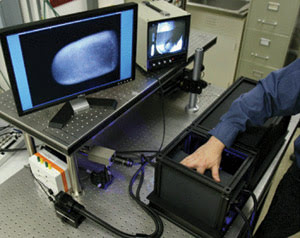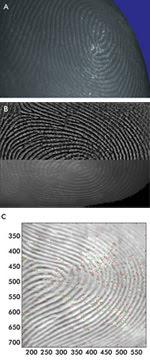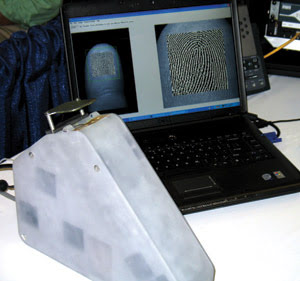From identification to communication, photonics technologies play a key role in homeland security. That contribution is expanding, thanks to a variety of innovations.
For example, advances in biometrics that depend upon cameras, lights and image processing improvements could enable rapid identification at a distance. Also, by exploiting biochemistry and light, researchers have found a way to quickly detect ricin, a potent toxin that could be used as a bioterrorism agent. And as a final example, quantum technologies, which make use of light, could yield communications that cannot be intercepted.
A look at these homeland security applications illustrates how photonics technologies are being used, what challenges there are and where things might be headed.
Getting – and giving – a hand
With regard to biometrics, the Department of Homeland Security (DHS) faces a big challenge, said Arun Vemury, a program manager in the organization’s Science and Technology Directorate. “We have to process a huge number of people on a daily basis.”
The group that currently must undergo some sort of biometric identification includes non-US citizens entering the country, resulting in the screening of more than a million people daily. That number likely will grow, both from increased travel and from expansion of those subject to verification. The biometrics collected today include a digital photograph and a set of fingerprints. The latter places an added burden on the DHS because the agency must perform a fingerprint check on some 135,000 people who are applying for visas every day.

The US Department of Homeland Security is working with vendors to develop high-throughput, high-image-quality contactless fingerprint systems. A prototype is shown here. Courtesy of the Science and Technology Directorate of the Department of Homeland Security.
The speed and quality of the biometrics collected originally and at the point of entry have a significant effect on the overall performance and throughput of the system. Moreover, if the entry biometric screening process is too slow or error prone because of poor image acquisition, a natural inclination will be to wave off the check, thereby decreasing security.
For that reason, image quality is important, Vemury said. “What we want to do is image the fingers effectively the first time.”
For public health and acceptance reasons, the DHS would like to collect fingerprints without contact. However, no available system is contactless, fast and high quality. So the agency is helping to develop technologies that offer these capabilities, with projects that Vemury characterized as high risk and high reward.
Two techniques are under development. One, from GE Global Research of Niskayuna, N.Y., incorporates an electrically variable focus based on polarization switching that is used to create two- and three-dimensional data. The second has its origins in research from the University of Kentucky in Lexington and is being developed for the DHS by FlashScan3D of Richardson, Texas. Based on structured illumination, it uses light patterns to capture the minute ridges and valleys of the fingerprint by the way the light scatters off those features.
Mike Troy, FlashScan3D’s CEO, noted that the illumination used is not a simple grid of light and dark. “We project multiple patterns of a single frequency at multiple phases to increase the 3-D accuracy of the system.”

Shown are images of fingertips, with the 3-D data (A, B) converted into 2-D equivalents (C). Courtesy of the Science and Technology Directorate of the Department of Homeland Security.
He added that one of the benefits of the structured illumination approach is that it can be done with off-the-shelf equipment. Most of the secret to getting the technique to work comes from the image processing and software.
Vemury said that the DHS would like to have an operational prototype of a contactless fingerprint scanner ready for deployment by 2011. The project has a series of go/no-go points, with the decision made at each as to the viability of a particular approach. Currently, although the results are promising, it is unknown whether either of the two techniques will result in a suitable solution.
A complicating factor for any noncontact 3-D scanner has to do with the vast databases of fingerprints that have been collected over time by law enforcement agencies. Most are traditional and latent prints, with the latter lifted from a crime scene. They are all 2-D, as have been all of the ones collected digitally so far. Thus, these have all been images of slightly deformed fingers, somewhat warped because they’re pressed against a hard surface. For compatibility reasons, then, 3-D data must be converted to the equivalent 2-D image that would have resulted from rolling a finger across a surface.

A prototype contactless 3-D fingerprint system based on structured illumination is in the foreground, with the captured image visible on the laptop screen behind it. Courtesy of FlashScan3D.
Spoof proof
There are, of course, other biometrics besides fingerprints that can be collected without contact and at a distance, including face and iris recognition. The latter often is done using a near-infrared source and detector, in part because this approach produces images from which the fine texture of the iris can be extracted more easily, said Martin Herman, chief of the information access division at the National Institute of Standards and Technology (NIST) in Gaithersburg, Md. His group works to develop biometrics for such things as computer log-on, building access and law enforcement.
He noted that iris scans already offer remote identity verification. “In some existing systems, the iris can be up to a couple of meters or more from the camera.”
One problem that confronts all biometrics is that no single approach works for everyone under all circumstances. People can be missing body parts or simply have features that are difficult to distinguish. One solution is the use of multiple biometrics technologies, such as systems that check both fingerprints and facial features.
Multimodal systems also help prevent spoofing, where someone uses an aid to pretend to be someone else. It could be fake fingerprints constructed from a gelatin or a picture that is held in front of a camera. Multiple biometrics would force any spoofer to come up with a fingerprint, a photo or perhaps something else. Although that would help prevent spoofing, Herman said a better answer might be to develop better liveness testing, techniques that weed out dead substitutes from a live person with more certainty.
Another contactless biometric is found in a vascular pattern scanner from Identica Holdings Corp. of Tampa, Fla. The scanner uses near-infrared imaging to penetrate approximately 4 mm into the back of the hand, extracting the vascular pattern found underneath the skin. The result is a unique signature, with the company claiming a verification rate of <0.5 s per person and a false rejection rate of 0.01%.

Identification is made via the back of the hand. Near-infrared scanning extracts the vascular pattern below the skin, and that serves as an identifying biometric. Courtesy of Identica Holdings Corp.
Other advantages to the approach are that it works with nearly everyone, operates in an outdoor environment and is not affected by dirt, grease, scars, cuts or other surface features on users’ hands, said Terry Wheeler, Identica’s president. Given that the company is targeting port applications, the latter capability is particularly important.
No one inadvertently can leave a vascular pattern behind, something that is not the case with fingerprints. Leaving no trace behind can be an important privacy plus. Furthermore, that invisibility leads to another benefit, Wheeler noted. “Because you can’t leave it behind and you can’t see it, it is also impossible to spoof.”
The company’s products recently were approved by the Transportation Security Administration, which is part of the DHS, for use in identification of port workers. It’s the only nonfingerprint system that has been approved, Wheeler said.
Testing for a toxin
Photonics-based techniques show up in more homeland security settings than access control and border crossing solutions. They also are being put to use in detecting toxins that could be employed in bioterrorism.
When correctly processed, the common castor bean can yield the protein ricin, a potent toxin for which there is no known antidote. It has been used for assassination and could be used in a terrorist attack, although to date that hasn’t happened.
One problem had been that ricin detection methods were slow and laborious. Now a group from Albert Einstein College of Medicine of Yeshiva University in Bronx, N.Y., has devised a technique that takes only a few minutes. It also is 100 to 1000 times more sensitive than any other method, and it can be done on site.
Vern L. Schramm, professor of biochemistry, explained that he and graduate student Matthew B. Sturm took advantage of a unique reaction that ricin initiates in the cells that it kills – it removes adenine from ribosomes. The researchers converted the freed adenine to another molecule, adenosine triphosphate (ATP). They then used the ATP to generate light via a firefly luciferase reaction.
An intermediate biomolecule of the process also is the product of a luciferase reaction. Consequently, it is recycled, and that leads to an important benefit. “This is an amplification cascade, in the same way you would see an amplification cascade in electronics, for example. A very small signal can give you a very large output,” Schramm said.
The result is an easily detectable yellow glow that appears whenever ricin is present. Sturm and Schramm’s work appears in the April issue of Analytical Chemistry, where they describe the method and show that it worked on a small-molecule RNA substrate that mimics the reaction of a human cell to ricin.
Schramm said that the ingredients needed for the test could be made into a dried powder. Water and the suspected ricin then could be added, with a photodetector measuring the resulting signal. The strength of that output would indicate the amount, if any, of ricin present.
There is also an application for the technique in medicine. Ricin linked to a targeting antibody could be used to destroy cancer cells. The problem is that this approach also would release ricin, which would have to be counteracted in some way.
What is needed is a way to quickly screen for ricin inhibitors. The new detection technique could do just that, allowing researchers to quickly test many compounds as they seek to develop a rescue therapy for ricin-based cancer treatment.
Securing communications
A final photonics contribution to homeland security comes in the form of highly secure communication. Techniques based on quantum mechanics promise to make it impossible for an eavesdropper to intercept a message without being detected.
So far, that’s only a theory, as actual implementation has run into a number of practical problems. BBN Technologies of Cambridge, Mass., built the world’s first quantum key distribution network implemented in metropolitan scale optical fiber in 2003. The network used the quantum information carried by single photons to distribute a secret encryption key to remote locations. The key then would be used to encrypt information, and the setup presumably would allow secure rapid key changes, thereby improving the overall communication security. BBN ran the network uninterrupted for five years and operates it sporadically now to demonstrate its capabilities.
Jonathan L. Habif, a senior scientist at BBN, noted that the company used phase distribution to carry the quantum information, achieving a secret key exchange rate ranging from kilobits down to tens of bits per second. The rate varied with distance, with the highest number possible when the exchange was confined to the BBN campus itself.
Habif points to one component in particular as determining that exchange rate. “Our system performance was almost completely limited by mediocre-quality single-photon detectors,” he explained. “It turns out that it’s really hard to detect one single photon in the infrared, which is what you have to do.”
The company collaborated with NIST to develop superconducting single-photon detectors, and those led to a dramatic performance improvement in the secret key exchange rate. Since then, there have been other improvements, such as semiconductor single detectors that have just become commercially available.
Habif noted that scaling up the network to cover more area and include more nodes probably would require the development of quantum repeaters, devices that temporarily can store and then faithfully regenerate quantum information. For the network and its communication to be secure, the security of sources, detectors and repeaters must be assured. There also are security issues revolving around how to integrate a quantum network into an existing optical fiber network.
Carl J. Williams, chief of the atomic physics division at NIST and coordinator of its quantum information program, said that moving quantum information over anything but a short distance requires photons. For that reason, improving the underlying photonics devices – detectors, sources and the like – is critical.
Detectors, in particular, present a challenge, he said. “At the moment, we seem to know how to make detectors either fast or very highly efficient, but doing both simultaneously remains very hard.”